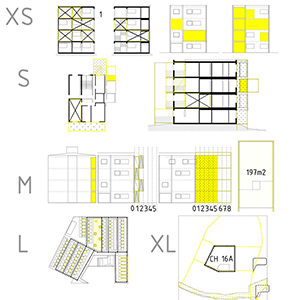Activation of vulnerable housing estates in four sustainable habitat principles: exteriority, diversity, sociability, comfort
DOI:
https://doi.org/10.35305/23626097v9i16.363Keywords:
habitat, sustainable, activator, multi-scaleAbstract
The four principles of sustainable habitat which are introduced in this work -exteriority, diversity, sociability, and comfort- arise from a thorough observation of the reality of “vulnerable” housing estates by means of the application of a multi-scale/multi-themed analysis method (MAM). This analysis gives raise to interpretations fostering the promotion of actions which lead to favorably transform inhabitants' daily universe within the estates since they enable living outdoors, living differently, living with others, and living comfortably. These conditions are as elementary-human- as essential.
Activation of vulnerable estates is a way of understanding the urban-building sustainability that enhances the built residential heritage; it is supported by a perspective which encompasses project continuity, community preservation, and city construction as a constant and cumulative process.
Micro-projects -which we call activators- are actions capable of generating immediate and direct activations at different scales of the estate, from the intimacy of the room to the neighborhood. In this way, the micro-project places the user at the center, it makes him a participant, and it provides him with the conditions of sustainable habitat.
Downloads
Metrics
References
Borrego, I. (2006). Editorial: Arquitectura enzimática. Arquitectos, 179.
Cabrera Recoba, A. (2021). Aportes para el reproyecto de conjuntos habitacionales vulnerables. Micro acciones que promueven la exterioridad. Hábitat & Sociedad. 14, 339-352.
Castel, R. (1997). Las metamorfosis de la cuestión social: una crónica del asalariado. Barcelona: Paidós.
De la Puerta, J. M. y Altozano, F. (2010). Vivienda, envolvente, hueco. Un catálogo de soluciones constructivas para la vivienda. Madrid, España: Actar Publishers.
Druot, F., Lacaton, A. y Vassal, J. (2007). Plus. La vivienda colectiva. Territorio de excepción. Barcelona, España: Editorial Gustavo Gili
Ecosistema Urbano. (2022). Web oficial Ecosistema Urbano. Recuperado de https://ecosistemaurbano.com
Grupo de investigación HABITAR de la Universidad Politécnica de Catalunyaa [Monteys, X., Mària, M., Fuertes, P. Puigjaner, A., Sauquet, R., Marcos, C., Callís, E., Fernández Rovira, C y Linares, O.]. (2010). Rehabitar: en nueve episodios. Barcelona, España: Departamento de Proyectos Arquitectónicos-UPC. Recuperado de http://www.habitar.upc.edu/wp-content/uploads/rehab1.pdf
Grupo de investigación NuTAC [Ruiz Cabrero, G. et al]. (2009). I+D+S: Futuros de la vivienda social en 7 ciudades. Madrid, España: Urbanística, Proyectos y Construcción de la Universidad Politécnica de Madrid. Recuperado de https://apps.fomento.gob.es/CVP/handlers/pdfhandler.ashx?idpub=BAW004
Koolhaas, R. (2010). Cronocaos. 12º Bienal de Venecia. Disponible en: https://www.oma.com/projects/venice-biennale-2010-cronocaos
Lerner, J. (2005). Acupuntura Urbana. Barcelona, España: Institut d’Arquitectura Avançada de Catalunya.
Sennet, R. (2008). El artesano. Recuperado de http://iupa.edu.ar/sitio/wp-content/uploads/2016/06/
Sennett, R. (2019). Construir y habitar. Ética para la ciudad. Recuperado de https://www.anagrama-ed.es/view/21840/Construir%20y%20habitar
Vigliecca, H. (2012). Áreas urbanas críticas, Monolito, 7, 92-99.

Published
How to Cite
Issue
Section
License
Open access policy
A&P Continuidad is a non-profit and open access publication. According to Mexico Declaration on Cultural Policies, the journal distribution is submitted to Creative Commons Attribution-Noncommercial-ShareAlike 4.0 International Public License (CC BY-NC-SA). “Neither the commercial use of the original work nor that of the possible derivative works are allowed. The distribution of derivative works should be submitted to the license regulating the original work. This license is not free.”
A&P Continuidad authorizes the partial or full reproduction of texts and graphs provided that the source is cited. Authors are exclusively responsible for the criteria expressed in the articles which do not necessarily reflect the opinion of the Editorial Committee or that of the Direction Board. The copyright of the published articles pertains to their authors or publishers.
Transfer of rights
The acceptance of an article to be published implies the author’s transfer of rights to the journal. Authors continue to have the right to use the material in future books or publications, approve or veto the republication of their works as well as the rights related to patents or other rights. Transfer of rights form may be downloaded here.























 This OJS site and its metadata are under a
This OJS site and its metadata are under a 

